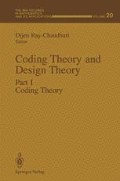Abstract
Maximal doubly-even self-orthogonal binary linear codes correspond to the maximal elementary abelian 2-groups of the spinor group Spin(n). We will describe the correspondence and discuss various techniques from the algebraic topology of Spin(n) which may be useful in studying self-orthogonal codes. In particular, Quillen’s results in equivariant cohomology theory coupled with some Morse theory may allow one to address certain questions on the minimum weight of doubly-even self-orthogonal codes.
Access this chapter
Tax calculation will be finalised at checkout
Purchases are for personal use only
Preview
Unable to display preview. Download preview PDF.
References
Michael F. Atiyah and Raoul Bott, The Yang-Mills equations over Riemann surfaces, Philosophical Transactions of the Royal Society of London, A 308 (1982), pp. 523–615.
Michael F. Atiyah, Raoul Bott and Arnold Shapiro, Clifford Modules, Topology, 3(Supp 1) (1964), pp. 3–38.
Armand Borel, Seminar on Transformation Groups, Annals of Mathematics Studies 46, Princeton University Press, Princeton, N. J., 1960.
Armand Borel, Sous-groupes commutatifs et torsion des groupes de Lie compacts connexes, Tôhoku Mathematical Journal, 13 (1961), pp. 216–240.
Armand Borel, On the p-rank of compact connected Lie groups, preprint 1987.
Armand Borel and Jean-Pierre Serre, Sur certains sous-groupes des groupes de Lie compacts, Commentarii Mathematici Helvetici, 27 (1953), pp. 128–139.
Raoul Bott, Nondegenerate critical manifolds, Annals of Mathematics, 60 (1954), pp. 248–261.
Raoul Bott, The stable homotopy of the classical groups, Annals of Mathematics, 70 (1959), pp. 313–337.
Theodor Bröcker and Tammo tom Dieck, Representations of Compact Lie Groups, Graduate Texts in Mathematics 98, Springer-Verlag, New York, Berlin, Heidelberg, Tokyo, 1985.
John H. Conway and Vera Pless, On the enumeration of self-dual codes, Journal of Combinatorial Theory, Series A, 28 (1980), pp. 26–53.
Simon K. Donaldson, An application of gauge theory to the topology of 4-manifolds, Journal of Differential Geometry, 18 (1983), pp. 279–315.
Theodore Prankel, Critical submanifolds of the classical groups and Stiefel manifolds, in Differential and Combinatorial Topology: A Symposium in Honor of Marston Morse, Stewart S. Cairns, editor, Princeton University Press, Princeton, N. J., 1965, pp. 37–53.
Daniel S. Freed and Karen K. Uhlenbeck, Instantons and Four-Manifolds, Mathematical Sciences Research Institute Publications 1, Springer-Verlag, New York, Heidelberg, Berlin, 1984.
Sigurdur Helgason, Differential Geometry, Lie Groups, and Symmetric Spaces, Pure and Applied Mathematics 80, Academic Press, New York, San Francisco, London, 1978.
Shoshichi Kobayashi and Katsumi Nomizu, Foundations of Differential Geometry, Interscience Tracts in Pure and Applied Mathematics 15, Interscience Publishers, New York, London, Sydney, 1963/1969.
Saunders MacLane, Homology, Grundlehren der mathematischen Wissenschaften 114, Springer- Verlag, Berlin, Göttingen, Heidelberg, 1963.
F. J. MacWilliams and N. J. A. Sloane, The Theory of Error-Correcting Codes, North-Holland Mathematical Library 16, North-Holland, Amsterdam, New York, Oxford, 1978.
Haynes Miller, Stable splittings of Stiefel manifolds, Topology, 24 (1985), pp. 411–419.
John W. Milnor, Morse Theory, Annals of Mathematics Studies 51, Princeton University Press, Princeton, N. J., 1969.
John W. Milnor and James D. Stasheff, Characteristic Classes, Annals of Mathematics Studies 76, Princeton University Press, Princeton, N. J., 1974.
Vera Pless, A classification of self-orthogonal codes over GF(2), Discrete Mathematics, 3 (1972), pp. 209–246.
Vera Pless and N. J. A. Sloane, On the classification and enumeration of self-dual codes, Journal of Combinatorial Theory, Series A, 18 (1975), pp. 313–335.
Daniel Quillen, The spectrum of an equivariant cohomology ring I,II, Annals of Mathematics, 94 (1971), pp. 549–602.
Daniel Quillen, The mod 2 cohomology rings of extra-special 2-groups and the spinor groups, Mathematische Annalen, 194 (1971), pp. 197–212.
Norman Steenrod, The Topology of Fibre Bundles, Princeton University Press, Princeton, N. J., 1951.
George W. Whitehead, Elements of Homotopy Theory, Graduate Texts in Mathematics 61, Springer-Verlag, New York, Heidelberg, Berlin, 1978.
Jay A. Wood, Spinor groups and algebraic coding theory, Journal of Combinatorial Theory, Series A (to appear).
Jay A. Wood, Flat connections, spinor groups and error-correcting codes, submitted to the Proceedings of the 1988 Northwestern International Conference on Algebraic Topology.
Author information
Authors and Affiliations
Rights and permissions
Copyright information
© 1990 Springer-Verlag New York, Inc.
About this paper
Cite this paper
Wood, J.A. (1990). Self-Orthogonal Codes and the Topology of Spinor Groups. In: Coding Theory and Design Theory. The IMA Volumes in Mathematics and Its Applications, vol 20. Springer, New York, NY. https://doi.org/10.1007/978-1-4613-8994-1_17
Download citation
DOI: https://doi.org/10.1007/978-1-4613-8994-1_17
Publisher Name: Springer, New York, NY
Print ISBN: 978-1-4613-8996-5
Online ISBN: 978-1-4613-8994-1
eBook Packages: Springer Book Archive

